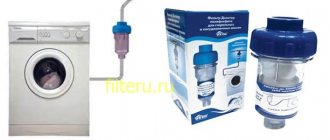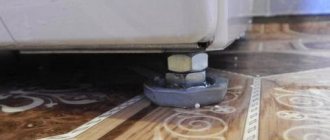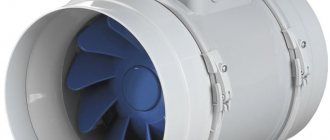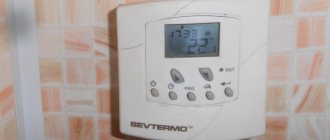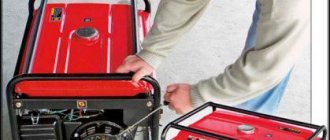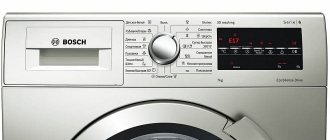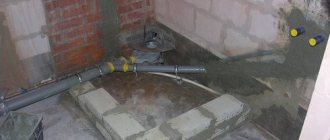Looking at the compact and simple in design Malyutka washing machine, it is difficult to believe that there is a very powerful engine inside it. The manufacturer managed to equip it with a rather large motor, which even had to be placed in a separate housing. But large size is not its only feature. This motor is also known for its highest reliability, as it can serve for many years without accidents. We invite you to take a closer look at the characteristics of the Malyutka washing machine engine and evaluate its advantages and potential.
Connecting the washing machine motor
To connect the motor to alternating current, perform the following steps:
1
.
First you need to prepare a tester - this is a special device used to determine the winding wires. 2
.
To determine a pair of wires, connect the tester probe to any wire and check all the others one by one. If during connection the tester indicated a connection, then this will be a pair of wires. Accordingly, the other two wires will also form a pair. 3
.
We measure the resistance level of two windings. The winding with a higher value is the starting winding. 4
.
Wires from different windings are connected in pairs, then connected to a 220 V network 5
. It is recommended to install the switch on the starting winding wire.
In some cases, the direction in which the motor rotates must be changed. Here we swap the leads of the starting winding.
What is needed to connect the motor
The operating principle of any electric motor is familiar to everyone; it is based on the rotation of a magnetic flux. When connecting single-phase electric motors, you don’t really need theory, so the following knowledge will suffice:
- You must have an understanding of the design of the electric motor you are working on.
- Know what purpose the windings are intended for, and also be able to carry out installation according to the electric motor connection diagram.
- Be able to work with auxiliary devices - ballast resistors or starting capacitors.
- Know how to connect an electric motor using a magnetic starter.
It is forbidden to turn on the electric motor if you do not know its model and the purpose of the terminals. Be sure to check what kind of winding connection is allowed when operating on a 220 and 380 V network. All electric motors must have a metal plate attached to the body. It indicates the model, type, connection diagram, voltage, as well as other parameters. If there is no data, then you need to use a multimeter to ring all the windings, and then connect them correctly.
Motor from an old washing machine for a lathe
Assembling a lathe yourself is not a difficult task. All you need to do is fix the adapter on the base of the motor shaft from an old washing machine. The adapter should not be permanently secured. It is better if it is removable, since this way the lathe will become multifunctional, with the ability to turn parts, sharpen knives with a sharpening wheel, cut metal and plastic pipes with a cutting wheel, and use other attachments. The photo shows possible attachments.
You should not fix this homemade product on a solid base. To make work more convenient, it is recommended to make it portable. The basis will be a thick, durable board. To secure the resulting lathe, it is recommended to use brackets that are screwed onto the base using bolts from the washing machine. A regular switch can be used, or from a washing machine.
Tips for use
With careful and proper handling, a washing machine can last much longer and require repairs less often. To do this you need to follow a few simple rules.
- When connecting, you need to carefully select wires based on power, brand and cross-section. Two-core aluminum cables cannot be used, but copper or three-core cables can be used.
- For protection, you must use a circuit breaker with a rated current of 16 A.
- Grounding is not always available in houses, so you need to take care of it yourself. To do this, you will need to separate the PEN conductor and install a grounded outlet. It is better to choose a model with ceramic fittings and a high protection class, especially if the “washing machine” is in the bathroom.
- When connecting, do not use tees, adapters and extensions.
- If there are frequent voltage fluctuations, it is necessary to connect the washing machine through a special converter. A good option is an RCD with parameters no higher than 30 mA. The ideal solution would be to organize catering from a separate group.
- Children should not be allowed near the machine for playing with buttons on the control panel.
Do not change the program during washing.
Grain crusher from a washing machine
With this useful homemade product, you can significantly save on the preparation of feed for domestic animals. If you choose an engine of sufficient power, it is quite possible to assemble a feed cutter, grain crusher and grass cutter, which will not be inferior in performance to factory models. In this case, it is recommended to use an engine from an automatic washing machine - they are distinguished by higher power.
It doesn't take a lot of work to turn an old washing machine into a feed cutter. You need to take an engine from an automatic machine and a body from another old washing machine - with a top load. It’s quite easy to find such a case; it costs pennies at a scrap metal collection point.
Step-by-step description of creating a feed cutter with your own hands:
1
.
The blades with knives should have a diameter such that they do not reach quite a bit to the edges of the body. 2
.
We make a hole in the bottom to remove the finished food. 3
.
We install one blade with knives in the lower part of the body, the other - 40–50 cm from the upper edge; To ensure better grinding quality, you need to use 2 different shafts for the knives, they should rotate in different directions. 4
.
We screw the motor onto the lid of the washing machine and attach it to the shafts. 5
.
We cut a hole in the lid to fill in the raw materials. 6
. We install the cover in place and test the homemade product in action.
Such a homemade device will function no worse than a factory one, and will allow you to obtain high-quality ground feed.
Types of motors
Asynchronous
- Simplicity of design.
- Easy maintenance.
- Fairly low noise level.
- Inexpensive cost.
Among the disadvantages, it can be noted that it has:
- low efficiency and;
- impressive in size.
Often such engines are used in inexpensive washing machines.
Collector
- Modest dimensions.
- Huge starting point.
- Simplicity of the control circuit.
- Short service life.
- Weakening of the magnetic field, which subsequently prevents the drum from rotating.
Direct drive
- Simplicity of design.
- It has an efficiency higher than that of other types of engines, while the vibrations of the machine are much lower.
- The sound level emanating from the MCA is also low.
- Due to the complexity of the circuit, manufacturers need to put in more effort, which increases the cost.
Emery from a washing machine motor
An emery machine is useful for almost any household.
It can be made in a simple way - for this it is enough to prepare the engine from an automatic washing machine in working condition. When you attach the sharpening stone to the motor, some difficulties may arise - the hole of the stone may not coincide with the diameter of the electric motor shaft.
In this case, you need to take an additional part that will need to be specially machined. This adapter can be easily made by any turner; you just need to tell him the diameter of the shaft.
In addition to the adapter, you need to have a special bolt, nut, and washer.
The thread on the nut should be cut depending on which direction the motor will rotate.
In order for the motor to rotate clockwise, the thread must be left-handed; for counterclockwise rotation, the thread must be right-handed.
If you do the opposite, the stone will constantly unwind and fly off during work.
It may be that you have a nut, but the thread direction is not correct. Then we change the direction of rotation. In this case, we swap the winding wires.
We connect the working winding to a 200 V network, connect the starting pair to the working coil.
We apply the second end to the winding terminal for a short time. The commutator electric motor will begin to move in one direction.
When the locations of the starting winding terminals change, the direction of movement of the motor will change to the opposite.
How to connect via capacitors
First, decide which circuit is assembled on the ED. To do this, open the bar cover where the blood pressure terminals are output, and see how many wires come out of the device (most often there are six).
The designations are as follows: C1-C3 are the beginnings of the winding, and C4-C6 are its ends. If the beginnings or ends of the windings are combined with each other, this is a “star”.
The most difficult situation is if six wires simply come out of the housing. In this case, you need to look for the corresponding designations on them (C1-C6).
To implement a scheme for connecting a three-phase electric motor to a single-phase network, two types of capacitors are required - starting and working.
The first ones are used to start the electric motor at the first moment. As soon as the rotor spins to the required number of revolutions, the starting capacitance is excluded from the circuit.
If this does not happen, there may be serious consequences, including engine damage.
The main function is performed by working capacitors. Here it is worth considering the following points:
- Working capacitors are connected in parallel;
- The rated voltage must be at least 300 Volts;
- The capacity of the working capacitors is selected taking into account 7 µF per 100 W;
- It is desirable that the type of working and starting capacitor be identical. Popular options are MBGP, MPGO, KBP and others.
If you take these rules into account, you can extend the life of the capacitors and the electric motor as a whole.
Capacity calculations must be made taking into account the rated power of the electric motor. If the motor is underloaded, overheating is inevitable, and then the capacity of the working capacitor will have to be reduced.
If you choose a capacitor with a capacitance less than acceptable, the efficiency of the electric motor will be low.
Remember that even after the circuit is turned off, the voltage remains on the capacitors, so it is worth discharging the device before starting work.
Also note that connecting an electric motor with a power of 3 kW or more to conventional wiring is prohibited, as this can lead to the machines turning off or the plugs burning out. In addition, there is a high risk of insulation melting.
To connect ED 380 to 220V using capacitors, proceed as follows:
- Connect the containers to each other (as mentioned above, the connection should be parallel).
- Connect the parts with two wires to the electric motor and a single-phase alternating voltage source.
- Turn on the engine. This is done in order to check the direction of rotation of the device. If the rotor moves in the desired direction, no additional manipulations are needed. Otherwise, the wires connected to the winding should be swapped.
With a capacitor, an additional simplified one is for a star circuit.
With a capacitor, an additional simplified one is for a triangle circuit.
Lawn mower made from a washing machine motor
A lawn mower is another example of how you can intelligently use a motor from a washing machine. This unit will be very useful if you have a summer cottage or garden plot. To make a lawn mower, you don't need many parts; all the materials can be found among household supplies in the garage or workshop.
DIY vibration table
Using the motor from a washing machine, we can make a vibrating table for paving slabs.
Equipment of this type is constructed in a fairly simple way. A homemade vibrating table is made in the form of a plate, which is the upper part of the device, attached to a metal base using a movable connection, with a motor with an eccentric from a washing machine. When the slab vibrates, air bubbles come out of the concrete that is poured into the molds on this slab and voids disappear. Thanks to this, the finished products are characterized by high strength and quality.
Reading time: 8 minutes No time?
We will send the material to you by e-mail
Scrap metal collectors will be happy to take your old washing machine. But don't rush to please them. You won't get much money for scrap, but if you approach this issue wisely, you can get a lot of useful things for your household. Homemade products made from a washing machine engine will help you quickly de-feather poultry, cut pet food, mow the lawn, and smoke fish and meat. And this is not a complete list of what can be made from a washing machine. Today in the review by the editors of HomeMyHome.ru there are detailed instructions on how to give the “iron heart” of a washing machine a new life.
Parts from a washing machine - material for many useful homemade products
Speed regulation
A speed controller is required for proper operation.
The washing machine motor is characterized by a fairly high rotation speed, so it is advisable to make a special regulator so that the hammer motor can operate at different speed modes without overheating. For this purpose, you can use a regular light intensity relay, but slightly modified.
It is necessary to remove the triac along with the radiator from the “washing machine” - the so-called semiconductor device (in electron control it functions as a controlled switch). Then you need to solder this device into the relay chip, replacing low-power parts. If you do not know all the nuances of this procedure, it is better to ask a specialist (electronics engineer or computer engineer) for help.
There are times when the engine performs new work without the help of a speed controller.
What can an engine from an old washing machine look like?
If you are planning to make homemade products from a used engine, you need to figure out what it is and what it is capable of. In washing machines you can find three types of motors: asynchronous, brushless and commutated. Let's take a closer look at them:
- Asynchronous - can be two-phase or three-phase. Two-phase engines are found in older Soviet-made models. More modern machines are equipped with three-phase. The design of such an engine is extremely simple; it can reach speeds of up to 2800 rpm. The working engine removed from the machine just needs to be lubricated - and it is ready for new exploits.
Such motors are characterized by quiet operation. Their only drawback is their impressive dimensions.
- Commutator – you will find this type of motor in the design of most household appliances. Such devices can operate from direct and alternating current, have compact dimensions and a controlled speed. The only drawback of such an engine is the brushes that wear out, but these parts can be replaced if necessary.
It must be admitted that, in comparison with an asynchronous motor, such a motor is noisier. In addition, it often overheats and even sparks
- Brushless direct drive is the most modern motor from the Korean manufacturer. You will find it in modern washing machines from LG and Samsung.
Such models are the most compact. They are characterized by wear resistance, simplicity of design and high efficiency.
Now that you can determine the type of motor, all that remains is to decide where you can use the motor from the washing machine.
Kinds
Asynchronous
Motors of this type consist of two parts - a stationary element (stator), which acts as a supporting structure and serves as a magnetic circuit, and a rotating rotor, which drives the drum. The engine rotates as a result of the interaction of the alternating magnetic field of the stator and rotor. This type of device was called asynchronous because it is not capable of achieving the synchronous speed of the rotating magnetic field, but follows it, as if catching up.
Asynchronous motors are found in two versions: they can be two- and three-phase. Two-phase samples are rare today, since on the threshold of the third millennium their production practically ceased.
The weak point of such an engine is the weakening of torque. Outwardly, this is manifested by a violation of the drum’s trajectory - it sways without making a full revolution.
The undoubted advantages of asynchronous type devices are the simplicity of the design and ease of maintenance, which consists of timely lubrication of the motor and replacement of failed bearings. The asynchronous motor operates quietly and is quite cheap.
The disadvantages of the device include its large size and low efficiency.
Typically, these engines are equipped with simple and inexpensive models that are not very powerful.
Collector
Commutator motors have replaced two-phase asynchronous devices. Three quarters of household appliances are equipped with motors of this type. Their feature is the ability to operate on both alternating and direct current.
To understand the operating principle of such an engine, let us briefly describe its structure. The collector is a copper drum divided into even rows (sections) by insulating “partitions”. The contact points of these sections with external electrical circuits (the term “terminals” is used to designate such areas in electrical engineering) are located diametrically, on opposite sides of the circle. Both brushes are in contact with the leads - sliding contacts that ensure interaction between the rotor and the motor, one on each side. As soon as any section is energized, a magnetic field appears in the coil.
When the stator and rotor are turned on directly, the magnetic field begins to rotate the motor shaft clockwise. This happens due to the interaction of charges: like charges repel, different charges attract (for greater clarity, remember the “behavior” of ordinary magnets). The brushes gradually move from one section to another - and the movement continues. This process will not be interrupted as long as there is voltage in the network.
To direct the shaft counterclockwise, it is necessary to change the distribution of charges on the rotor. To do this, the brushes are turned on in the opposite direction - towards the stator. Typically, miniature electromagnetic starters (power relays) are used for this.
Among the advantages of a commutator motor are a high rotation speed, a smooth change in speed, which depends on changes in voltage, independence from the oscillation frequency of the power supply, high starting torque and compactness of the device. Among its disadvantages is a relatively short service life due to rapid wear of the brushes and commutator. Friction causes a significant increase in temperature, resulting in the destruction of the layer that insulates the contacts of the collector. For the same reason, an interturn short circuit may occur in the winding, which can cause a weakening of the magnetic field. The external manifestation of such a problem will be a complete stop of the drum.
Inverter (brushless)
An inverter motor is a direct drive motor. This invention is a little over 10 years old. Developed by a well-known Korean concern, it quickly gained popularity due to its long service life, reliability, wear resistance and its very modest dimensions.
The components of this type of motor are also a rotor and a stator, but the fundamental difference is that the motor is attached directly to the drum, without the use of connecting elements, which are the first to fail.
Among the undoubted advantages of inverter motors are simplicity, the absence of parts subject to rapid wear, convenient placement in the machine body, low noise and vibration levels, and compactness.
The disadvantage of such a motor is that it is labor intensive - its production requires a lot of cost and effort, which significantly affects the price of inverter machines.
We properly disassemble and decide what can be made from parts of an old washing machine
Disassembling a washing machine is a leisurely task. After working with water, a salt build-up may remain on the parts; it must be carefully removed so as not to damage the parts during removal. What can be made from an old washing machine? A motor will be useful for homemade projects - it will become the basis for many devices. The drum will also come into play. It is usually made of stainless steel. All pipes must be disconnected from the drum. A loading hatch may also be useful. In addition to these parts, do not rush to throw away springs, counterweights and body parts.
For those who are versed in electronics, you may need a circuit board - it can easily be used to find spare parts for repair work if necessary.
Engine power and energy consumption
People are often concerned about how many kilowatts the machine will “eat” on average per wash cycle. Many people want the machine to be as economical as possible. In general, the energy consumption of washing equipment depends on many factors:
- motor power - and the amount of electricity consumed by the engine will change, depending on the running washing program;
- technical characteristics of the heating element. The amount of “consumed” kilowatts is also affected by the power of the tubular heater (it varies from 1700 to 2900 W) and the set washing temperature;
- drain pump power, this figure can range from 24 to 40 W;
- total power of indicators, sensors, electronic module and other elements. In general, the figure reaches 5-10 watts.
The energy consumption of a washing machine depends on the power of its motor, pump, heating element and system sensors.
So what indicator should the buyer focus on? On what basis is a washing machine assigned an energy efficiency class? The manufacturer indicates in the technical specifications the energy consumption of the automatic machine when the “Cotton” program is activated. This mode assumes full drum loading and “medium” water heating – up to 60 °C
The power of the motor determines how well the washing machine can spin. The maximum possible number of revolutions to which the electric motor is capable of spinning the drum is always reflected in the instructions for the equipment. For some models this figure does not exceed 800-100 rpm, for others it can reach 1600-2000 rpm.
How to make a sharpener or grinding device from a washing machine engine
A sharpener is one of the most popular tools for the home. It can be used to sharpen garden tools, household knives and scissors. If you don’t already have one, buy it at any tool store or make a sharpening machine from a washing machine. The most difficult part is how to attach the sanding wheel to the motor. The easiest way is to buy a ready-made flange. It looks something like this.
Flange for motor
You can machine a flange from a metal pipe of a suitable diameter; most often, a tube with a cross-section of 32 mm is suitable. You need to cut a piece 15 centimeters long from it, this is quite enough to fix the emery. The flange is secured to the motor shaft by welding or a through bolt. The video describes in detail how a homemade washing machine sharpener works:
How to turn on a commutator type engine
The appearance of motors of different models may differ, but the design and operating principle are almost identical. The device consists of:
- housings;
- stator;
- stator coils (shoes) with two, three terminals;
- anchors;
- shtiva;
- two brushes;
- collector;
- tachometer (with two, three wires);
- terminal block.
To connect the motor, you need to know the outputs of the armature, stator, and tachometer windings. The tester will help you avoid getting tangled among the wires.
How to connect an electric motor
Set the tester to the mode of least resistance, call the windings of the tachometer, coils, and armature. Make connections through the terminals that connect to each other to find a pair. If you have a design with 4 wires, then red-brown are the stator, gray-green are the rotor. The colors of the wires of different SMA models may differ. Therefore, use a multimeter. Did you get a device with 6 wires? Those on the left regulate the speed of the machine with a tachometer. Their resistance is about 70 ohms. A correctly connected device picks up speed smoothly, does not crackle, does not spark. You can check how many revolutions the motor makes using a speed sensor.
You can see how to start the engine from the washing machine here:
Rotation adjustment
There are many ways to control speed:
- laboratory autotransformer;
- adjustment board for household appliances;
- screwdriver buttons, grinders;
- lighting regulators (switches, toggle switches).
The adjustment scheme is simple, you can do it yourself.
This is a satisfactory option for a pump or fan. More powerful mechanisms (for example, machine tools) will require a different regulator circuit.
The essence of the issue is to reduce the speed while maintaining performance. The connection is made through a tachogenerator, which transmits the number of turns to the speed controller microcircuit, which coordinates the cycle with a thyristor.
This board allows you to increase or decrease speed, but requires constant, intense cooling due to overheating. A detailed video about adjusting speed, stroke force, and connecting the microcircuit can be viewed here:
Making a wood lathe from a washing machine
What else can you do with the washing machine motor? One popular idea is a wood lathe. Let's look at the step-by-step process.
| Illustration | Description of action |
| To firmly fix the engine on the workbench, make fasteners from a metal angle. To do this, drill holes for fixing to the motor legs and table. | |
| To fasten a wooden part, you will need a flange fixed to the motor shaft, and these are the studs made from ordinary bolts with cut off heads. Screw these pins into the base. You will need 3 studs. | |
| The motor is fixed to the table with self-tapping screws and to the metal part with bolts. | |
| The opposite end of the wooden part is attached with such a device. It consists of a screw with a loop, two wooden stands perpendicularly fixed to the corners. | |
| This wooden part must be movable so that different workpieces can be used. For mobility, it is mounted on a threaded stud with bolts. | |
| To control the motor you will need a power supply. You can use one of the computer units. You will need to install switches to adjust the rotation speed. | |
| How to connect a motor to a power supply in animation. | |
| To guide your tools, make a tool rest. It consists of two wooden parts and a metal corner. All parts are movable due to fastening with one bolt. | |
| The lower part of the tool rest is rigidly fixed on the workbench using self-tapping screws and corners. | |
| The workpiece is fixed on the machine on both sides: on the left - on studs, on the right - on a bolt with a handle. To fix it in the workpiece, you need to drill the corresponding holes. | |
| To work, you will need sharpened tools - cutters. | |
| Final sanding of the workpiece is done using a strip of sandpaper. |
Choosing capacitors
In this case, the process is accompanied by the transformation of kinetic energy into electrical energy.
You need to connect the two contacts of the capacitor to zero and the third output of the electric motor. In distribution
What is a star and triangle in an electric motor?
The capacitance of the starting capacitor must exceed the working capacitor. The main function is taken on by the working capacitors.
If the motor has one voltage, then there will be three pins, and the remaining pins are connected and located inside the motor. That is, the beginning of the first winding is above the end of the third, the beginning of the second is the end of the first, and the beginning of the third is above the end of the second. The main thing is that, as mentioned above, their operating voltage is not less than V. To connect the ED to B using capacitors, proceed as follows: Connect the capacitors to each other as mentioned above, the connection must be parallel. With a capacitor, an additional simplified one is for a triangle circuit.
It is due to this that it becomes possible to use two voltages at once for one engine. Photo - star-delta connection diagram To the first starter, which is designated K1, an electric current is connected on one side, and the stator winding is connected to the other. That is, the beginning of the first winding is above the end of the third, the beginning of the second is the end of the first, and the beginning of the third is above the end of the second. How to connect the motor 380 to 220 via capacitors - How to connect the motor 380 220
How to make a simple feather removal machine for home use from a washing machine with your own hands
The time of slaughtering a bird is a troublesome stage. This is usually done in the fall, when the ducks and broilers have reached the desired weight, and it is no longer profitable to keep them in the winter. You need to pluck several dozen or even hundreds of carcasses very quickly. You can get rid of hard labor with the help of a feather removal machine, and it’s easy to do everything from the same parts of the washing machine.
The only thing that can cause difficulties is the search for rubber fingers with threads - beaters. You will have to order them, so keep in mind that you need to think about making the machine long before slaughter
The device does not require disassembling the washing machine. It is especially convenient to use machines with vertical loading. You just need to fix the beats in the drum so that they point inward. Before plucking, the chicken carcass must be scalded with boiling water and then simply thrown into a rotating drum. Here's what happens:
Important! To prevent water from getting on the engine of the feather removal machine, you need to protect it with a plastic casing.
And the last point - the feather removal device must be firmly fixed, since the vibration when loading the carcass will be very strong.
Lawnmower from a used motor
We continue to look for the answer to the question of where we can use the motor from an automatic washing machine. Another original idea is making a lawn mower. For a small area, an electric model connected to a power source with a cord is quite sufficient. The design of such a unit is very simple. You will need to make a platform on four wheels with a small diameter.
The platform can be made of metal or OSB board, plywood and even the body of the same washing machine
The engine is fixed on top of the platform, the shaft is threaded into the hole below, and the knife is attached to it. All that remains is to attach handles and a lever to the cart to turn the power on and off. If you have an asynchronous motor lying around, you will be surprised at how quiet the unit will be, even compared to factory models.
Advice! To prevent grass from wrapping around the knives, you need to slightly bend their cutting edges down.
Video: how to make a lawn mower
Engine power of various SMA models
Washing machines from different manufacturers are equipped with electric motors that differ not only in cost, but also in technical parameters. Here are the main devices:
- MOTOR CESET MCA 52/64-148/AD9 – such engines are installed on Indesit and Hotpoint-Ariston machines, their power level at 11,500 rpm reaches 430 W;
- MOTOR CESET MCA38/64-148/CY15 – motors for units from Kandy, Zerovatt and Hoover companies. At 360 W they produce 13,000 rpm;
- MOTOR CESET CIM2/55-132/WHE1 – electric motors of this series can be found on washing units with a power rating of 800 W and a speed of 17,000. Examples of devices are Whirlpool and Bauknecht;
- WELLING HXGP2I.05 WASHING – another engine option for Indesit, also found on Vestel. When spinning, the power is 300 W, during washing it decreases tenfold;
- Elecronic Control Motor Haier HCD63/39 - this motor can be seen on Kandy or Haier; its power rating is 220 W, speed is 13,000;
- HXGP2I Welling Electronic Control Motor - motors of this brand are installed on devices for washing clothes from Samsung and Ardo, their power does not exceed 300 W.
Many people are interested in whether it is possible to make adjustments on modern engines, and how to increase the power of the unit? How to lower the speed so as not to disrupt performance? In this case, it is necessary to connect a tachogenerator, which transmits the number of turns to the microcircuit of the regulatory device, which coordinates the entire process through a thermistor.
How to build a generator from an old washing machine
We continue to look at homemade products from a washing machine motor, and the turn has come to the generator. You won't be able to assemble a powerful device, but in the event of an emergency shutdown, you can be well prepared. To turn the engine into a generator, you will have to disassemble it and partially cut off the core. In the remaining part of the core you need to make grooves for neodymium magnets.
The magnets must be placed in two rows with the same spacing
The gaps between the magnets are filled by cold welding. To operate the device, the kit must include a motorcycle battery, a rectifier and a charge controller. Details of the work in the video:
Homemade concrete mixer
If you have started a small renovation that requires, for example, plastering the walls, a concrete mixer will come in handy. Once again, washing machine parts will come in handy.
As a result, you will receive a compact device with low power, which you won’t mind throwing away after the repair work is completed.
As a container for concrete, you can use the same drum with pre-sealed holes for draining water. It is best to use parts from a front-loading machine; there will be almost nothing to redo. To strengthen the body, use a metal corner, and for convenient movement of the concrete mixer, equip it with wheels. The main difficulty in the design is the manufacture of a “swing” for the correct tilt and subsequent pouring of concrete. How to do it correctly in the video:
Correct connection of the engine
To properly connect the motor, which is left over from an old washing machine, a minimum amount of knowledge and a little effort is enough. Also for this purpose, a winding using a multimer is used. To locate the necessary wires, it is necessary to ring the winding. This will allow you to select the right pairs for connection. Everything is done very simply. The multimeter is connected to one wire, and with the other end of the device you should touch the other wires in turn to find the desired pair. It is also worth recording in advance what value of winding resistance is present. This information will be useful in the future. After completing the ringing procedure, you should have 2 windings that would have different resistance values.
These windings are divided into two completely different types. One has an operating resistance indicator. The second type of winding is one of the starting parts. It is known that the resistance value of the working winding should be less than the starting winding. In order for the motor from the washing machine to work fully, you need to use either a button or a special start relay. You can even use the one that is installed for the doorbell as a button. The main thing is that it does not have a fixed contact.
New life for an old motor - use for other purposes
The process of connecting the engine, which was left over from the old washing machine, is incredibly simple and easy. It is enough to find the right and useful use for it. Then it will be able to serve you for some time. You can experiment and make really useful equipment that will make your life easier in other areas. A little imagination and skill is enough to make everything work.
The electric motor of failed washing machines is often used to create new devices. They are used to make grinding machines, drilling machines, generators, circular saws, concrete mixers - the imagination of folk craftsmen knows no bounds. Do you also want to join the ranks of craftsmen by putting an old motor to good use? We will tell you how to connect the washing machine motor at home (garage).
What else can be made from a washing machine drum: original decor ideas
The drum with its correct perforation is a material for the manufacture of decorative objects. Here are some interesting ideas.
Ottoman with drum base. It’s easy to do – you just need to attach the wheeled legs and make a soft seat
Such a drum can also be turned into an original lamp. If you place a lamp inside, the perforated surface of the drum will cast glare on the walls. Such lamps will look good on the ceiling of the veranda or even on the floor
Bedside tables and tables. Drums with doors from top-loading machines can be used to hide small items.
This is how the drum turns into a cabinet or nightstand
Making a barbecue from a drum from a washing machine, photo examples
A metal grill is a temporary product. Sooner or later it burns out and requires replacement. You can buy a new one each time or use improvised material, for example, a drum from a washing machine. Making this craft from a washing machine drum takes a couple of minutes. The beauty is that oxygen easily enters the perforated container, which causes active combustion.
Kebab coals burn quickly, and the process of cooking meat is significantly accelerated
The metal of the drum can withstand a couple of seasons. Make a comfortable stand for it so you don’t have to bend over, and you’re done. Standard length skewers will fit comfortably on a small roasting pan. If necessary, you can lightly weld a couple of guides.
What experts say
Until now, no dependence has been identified on the speed of the machine, its service life and reliability. All models have different service lives, which are set by the manufacturer, who provides warranties and produces spare parts. Even those models that can spin no more than 600 rpm can still work for a whole decade. However, some manufacturers are reviewing the service life of their devices. Sometimes without even giving official statements about it.
For example, Ariston has reduced the service life of its machines from ten to seven years. Most experts attributed this to the fact that many complaints began to be received about the operation of equipment from this manufacturer. And thus, he decided to protect himself. Today, more and more companies have gradually begun to accept such a reduction in quality. Perhaps this is due to attempts to make their products cheaper for the buyer.
Did you like the article? Follow new ideas from the world of construction, design, and useful tips in our channel. Subscribe to us in Yandex.Zen. Subscribe.
Article rating:
Loading…
What speed should a good washing machine have? Link to main publication
